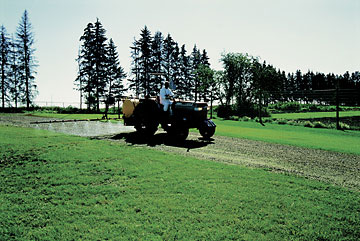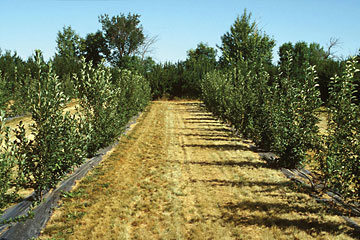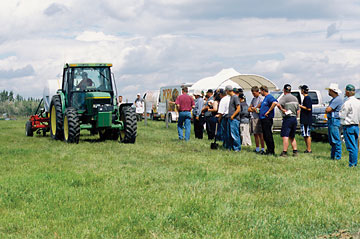| | Dust and Smoke | Odour | Noise | Preventing, Managing and Resolving Conflict | Role of the Farmers’ Advocate | Legislation | For more information
As agriculture and other land uses continue to compete for space in Alberta, nuisance conflicts will increase. Significant nuisances associated with farming operations include dust, smoke, odour and noise. Rural residents should consider how to best deal with and minimize these nuisances.
Dust and Smoke
Dust and smoke can be a concern for both rural residents and agricultural producers. Dust from traffic activities, whether from farming operations or road travel, and smoke from burning farm wastes can potentially create a nuisance for your neighbours. Practices to minimize or eliminate these nuisances will help lessen the conflicts that can occur. For more information regarding proper burning of debris, refer to the Burning section of Chapter 8.
The following BMPs can be used to minimize or eliminate dust as a nuisance:
- Reduce speed when driving near farmsteads or country residential homes and use the least travelled route during times of heavy traffic volumes.
- Inform neighbours when and for how long farm-related traffic volumes are going to increase during busy periods.
- Be aware of the effect heavy traffic may have on your neighbours and if possible adjust your road travel accordingly. This practice may mean a reduction in farm-related traffic in morning, at night and on weekends.
- Wet down gravel or dirt roads with water or oil during times of heavy traffic. (For more information on applying oil to your roadways in accordance with regulations refer to Chapter 8.)
- Pave roadways in front of yard if possible.
- Use shelterbelts or windbreaks to reduce dust movement.
- Clean or remove excess manure from corrals as dry weather approaches.
- Reduce or eliminate tillage in nearby fields to prevent dust from wind erosion.

Wetting down dirt or gravel roads helps control dust around the farmstead
Courtesy of PFRA
The following BMPs can be used to minimize or eliminate smoke as a nuisance:
- Consider alternative disposal methods for green material and other wastes that may produce lots of smoke.
- Notify the fire department of your activities and have fire fighting and safety equipment available on-site.
- Be aware of the effect smoke may have on your neighbours; consider not burning at all or if possible adjust your burning schedule accordingly. This practice may mean not burning in morning, at night and on weekends.
- Inform neighbours when and for how long smoke-producing activities are going to occur.
- Only burn when weather and wind conditions allow more air movement to disperse the smoke.
- Ensure smoke does not drift on to roadways or into neighbours’ yards by using proper containment units and providing smoke barriers.
- Ensure the fire is supervised and contained by providing a fuel-free buffer area.
Odour
Odours from farming practices, such as livestock production and manure storage and handling, can be major nuisances for nearby residences. Although it is very difficult to quantify the effects odours have on people, it is very important to be aware of the nuisance as it can potentially create conflicts among neighbours.
The following BMPs related to livestock production and manure storage and handling could be used to minimize or prevent odour as a nuisance and to resolve conflicts:
- Locate manure or compost storages a minimum distance of 150 m (492 ft) from neighbouring residences.
- Compost solid manure to reduce or eliminate odour during spreading.
- Select fields to avoid odour movement by wind into nearby neighbours’ yards or spread manure when the wind is blowing away from your neighbours.
- Use lagoon covers or natural crusts to reduce odour losses during the warm season.
- Notify neighbours of when and for how long odour-producing activities will occur.
- Time manure lagoon agitation just prior to spreading to minimize duration of odour contact time with neighbours.
- Alter spreading times to avoid spreading on weekends, evenings and holidays to minimize odour contact with neighbours.
- Spread manure during midday when odour dispersion is best, and avoid spreading on hot, humid days when there is little air movement.
- Avoid applying high rates of manure and apply below the plant canopy when possible.
- Incorporate manure as quickly as possible after spreading or use injection systems.
- Reduce spreader deflection angle on liquid broadcasters to reduce drift (apply as close to ground as possible).
- Irrigate (where applicable) following application.
- Other BMPs to avoid odour nuisances and conflicts associated with other practices on the farm include:
- Ensure the location of silage, mortality composting or other odour-producing practices are at adequate distances from neighbours.
- Design compost facilities correctly to ensure proper composting of material in a timely manner.
- Dispose of farm waste at proper waste management facilities.
- Use shelterbelts to manage odour movement by wind to neighbours.
- Tell neighbours or utilize signs in advance when odour-producing activities are planned.
- Time odour-producing activities to minimize contact time with neighbours.
Noise
Another nuisance associated with farming operations is noise. Many rural areas now have more non-agricultural landowners than before, and noise foreign to them from agricultural practices may become a nuisance. These noise concerns often relate to the volume, duration and/or timing of farming operations.
The following BMPs could be used to minimize or prevent noise as a nuisance and resolve conflicts:
- Advise neighbours in advance when noisy activities, such as calving or weaning occurs, and when planning to conduct loud operations, such as harvesting and grain drying.
- Time noisy activities, such as moving cattle or operating loud equipment, during the week and midday as opposed to weekends and evenings.
- Confine activities to areas remote from neighbours if possible.
- Use shelterbelts and windbreaks as noise barriers.
- Reduce engine noise by gearing up and throttling down.
- Prevent noise problems before they develop such as maintaining and repairing field equipment, machinery and vehicles.
- Avoid prolonged periods of idling equipment and vehicles near neighbours.
- Replace loud equipment with more efficient and quieter equipment.
- Locate loud building equipment, such as grain dryer or ventilation fans, on the opposite side of buildings away from neighbours.

Shelterbelts can help reduce dust, smoke, odour and noise concerns
Courtesy of ARD
Preventing, Managing and Resolving Conflict
Conflict is a struggle between two or more people because of a real or perceived difference in needs or values.
Properly managed conflict can be productive because it can:
- encourage people to examine issues more carefully
- deepen our understanding of problems
- open the door to new ideas and alternative solutions
- help foresee the consequences of proposed actions
- enable people to take risks and solve problems
Learning the skills necessary to prevent, manage and resolve conflict is important in today’s society. The most important thing producers can do to reduce the risk of conflict associated with nuisances is to ensure communication with neighbours is open, honest and thorough.
To communicate with your neighbour effectively:
- take the matter seriously, listen to and acknowledge concerns
- be diplomatic and ask questions to identify the real issues
- apologize, admit mistakes, and when others make mistakes, help them save face
- shift the emphasis to mutually acceptable solutions and offer to look into the matter
- promptly respond to complainants with information they need to relieve their concerns
- take responsibility and steps to mitigate damage or eliminate problems
- stay on top of on-going problems, while keeping neighbours informed of on-going progress on the farm

Host a tour for your neighbours to help them understand your operation
Courtesy of ARD
Be a Good Neighbour
Being a good neighbour helps to build trust and understanding when problems arise.
Practices to strengthen your relationship with your neighbours include:
- getting to know them and letting them get to know you and your farming operation
- being friendly and helpful to neighbours in need
- getting involved in the community by supporting local charities and community groups, such as sports teams and youth groups
- supporting local businesses and hiring local youths
- hosting a farm tour, picnic/barbecue or potluck to generate goodwill and provide an opportunity for neighbours to ask questions about your operation in a relaxed atmosphere
Role of the Farmers’ Advocate
The Alberta Farmers’ Advocate Office (FAO) receives nuisance complaints about non-regulatory concerns like odour, noise, dust, smoke or other disturbances resulting from agricultural operations. Once a complaint is received, the FAO staff will assess the situation and determine if the complaint is valid. If it is valid, then the Farmer's Advocate will take a proactive approach in mediating between the disputing parties by providing information, support and possible resolutions to address the issues of concern.
When a complaint concerns an agricultural operation that is meeting the regulations, the Farmers’ Advocate will provide the operator and complainant with possible solutions and systems to resolve their disagreement outside of the courts. The resolution process can help identify practical ways the farmer can address neighbours’ concerns. The process can also help complainants better understand what is involved in acceptable agricultural practices; this perspective can be especially important for people who are new to living in rural areas.
Legislation
Producers should be aware of the following pieces of legislation that pertain to nuisance issues. For more information on legislation, refer to Chapter 12 of this manual.
Provincial Legislation
Agricultural Operation Practices Act
Environmental Protection and Enhancement Act
Substance Release Regulation
For More Information
All Alberta government offices may be reached toll-free by dialing the Rite Line: 310-0000
Alberta Agriculture and Rural Development
Publications: 1-800-292-5697
Agricultural Operation Practices Act (AOPA) – 2004 Reference Guide Agdex 096-1
Beneficial Management Practices: Environmental Manual for Alberta Cow/Calf Producers Manual 2004 Agdex 420/28-2
Beneficial Management Practices: Environmental Manual for Crop Producers in Alberta 2004 - Agdex 100/25-1
Beneficial Management Practices: Environmental Manual for Dairy Producers in Alberta 2003 - Agdex 410/28-1
Beneficial Management Practices: Environmental Manual for Feedlot Producers in Alberta 2002 - Agdex 440/28-1
Beneficial Management Practices: Environmental Manual for Hog Producers in Alberta 2002 - Agdex 420/28-1
Beneficial Management Practices: Environmental Manual for Poultry Producers in Alberta 2003 - Agdex 450/28-1
Manure and Pasture Management for Horse Owners - Agdex 460/27-1
Meeting Odour Head On Fact Sheets
Ag-Info: 310-FARM (3276) Website: www.agric.gov.ab.ca
Farmers’ Advocate Office:
Office: 780-427-2433
Website: www.agric.gov.ab.ca/farmersadvocate
Sustainable Resource Development
Publications: 780-427-6807
- FireSmart: The Home Owners Manual No. I/189
Website: www.srd.gov.ab.ca
Canadian Farm Business Management Council
Phone: 1-800-232-3262
- Farming with Neighbours, A Guide for Canadian Farmers on Preventing and Resolving Community Conflicts over Farming Practices
Website: www.cfbmc.com
Canada Plan Service
Publications: 780-422-4844
- 10704-Odour Control for Livestock Facilities
Website: www.cps.gov.on.ca |
|